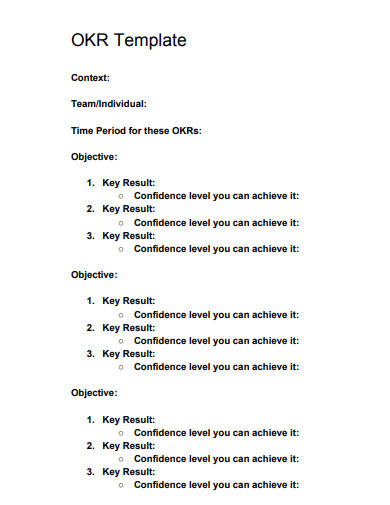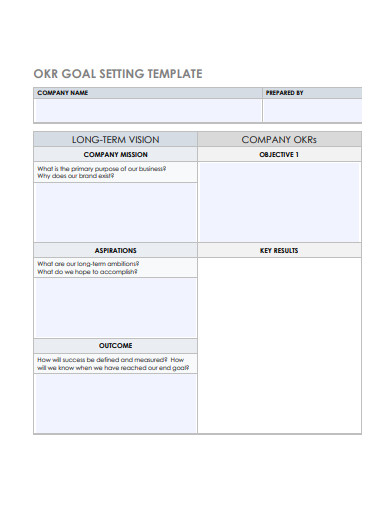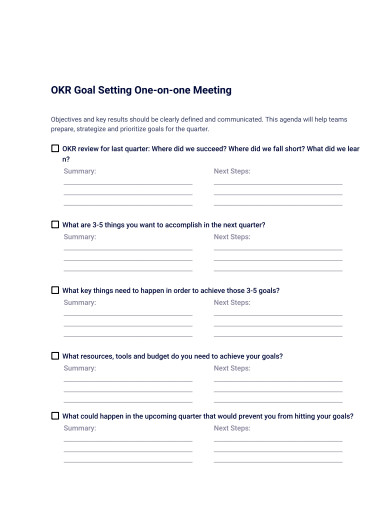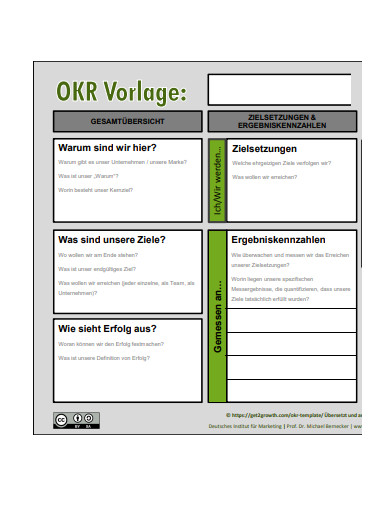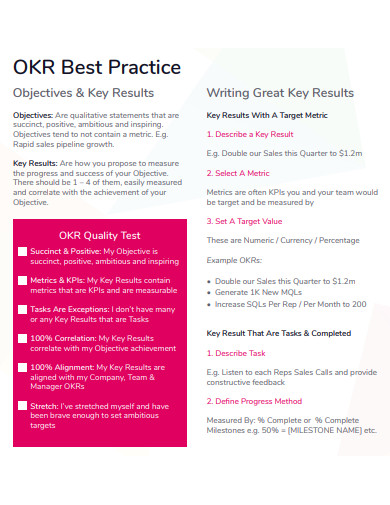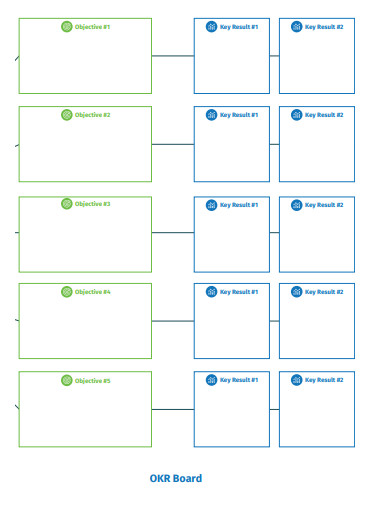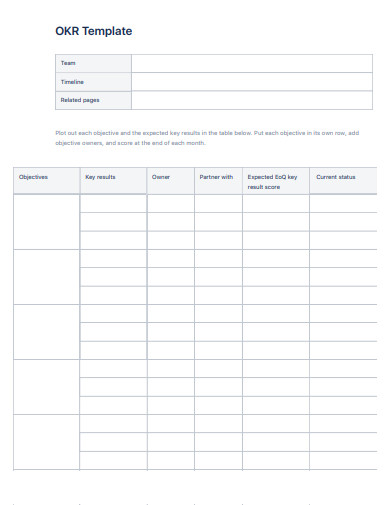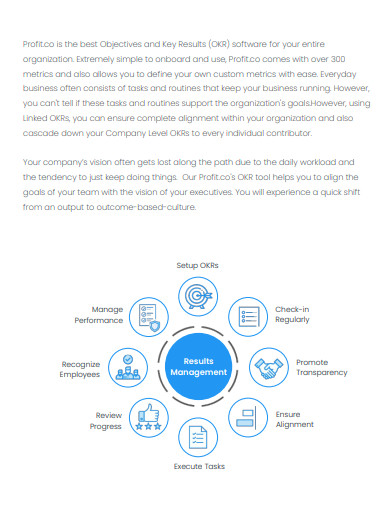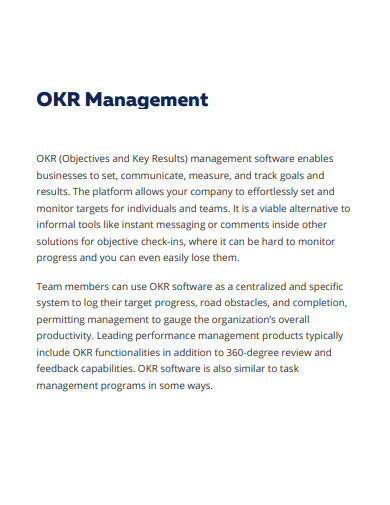As a business, you should have a vision – an end goal – to ensure that all of your ongoing efforts are aligned with the greater picture. Annual company goals are vital, but breaking them down into smaller emphasis areas allows them to remain flexible. According to 59 percent of experts, shifting to agile goals can be difficult and time-consuming because it necessitates changes in culture and performance management. Use the OKR goal-setting framework to enable agile goal-setting and empower your team to strive for the right business metrics. This comprehensive book will teach you everything you need to know about OKR technique and how they may help you achieve success.
8+ OKR Template Samples
OKRs are a collaborative goal-setting process used by teams and individuals to establish tough, ambitious goals with measurable outcomes. OKRs are a way to keep track of progress, align teams, and encourage participation in measurable goals. OKRs function the same way for creating goals at all levels of a firm, whether it’s in office operations, software engineering, nonprofits, or elsewhere. They can also be utilized for personal purposes, and individuals can use them to get things done in situations where senior management does not.
1. OKR Template
2. OKR Goal Setting Template
3. OKR Goal Setting Meeting Template
4. Formal OKR Sample
5. Simple OKR Template
6. OKR Board Sample
7. Basic OKR Template
8. OKR Management Template
9. Company OKR Management Sample
Components of OKR
The OKR goal-setting process begins with the company’s leadership defining the company’s broad objectives – areas that need to be improved. Functional teams/departments write team-specific Objectives and Key Results contributing to one or more of the overarching Objectives contextually provided by leaders and articulated by them. Team OKRs should be in line with the company’s goals and should be focused on changes that a team can make in a quarter’s time.
Individuals in that team can prioritize their daily tasks and understand how their work contributes to the wider picture by having a clear outcome-driven focus for the entire team.
- OKR formula – An Objective is usually written at the top of an OKR, with 3 to 5 supporting Key Results below it. “I shall (Objective) as evaluated by (Key Results),” they can also be phrased as a statement.
- Objectives – An objective is simply what must be accomplished, nothing more or less. Objectives are important, concrete, action-oriented, and (hopefully) motivating by definition. They’re a vaccine against hazy thinking and inefficient execution when they’re well-designed and implemented.
- Key results – Key Results serve as a baseline for measuring progress toward the goal. KRs that work are detailed, time-bound, and aggressive while being realistic. They are, above all, measurable and verifiable. There is no gray area, no space for question when it comes to meeting the requirements of a crucial result. We do a periodical check at the conclusion of the defined period, usually a quarter, and grade the important findings as fulfilled or not. Whereas an Objective can be extended for a year or more, Key Results change as the project advances. The Objective will be fulfilled once all of them have been performed.
FAQs
What is the difference between KPI and OKR?
Key Success Indicators, or KPIs, are a mechanism for teams to track performance across projects and initiatives. OKRs, on the other hand, are a goal-setting and achievement framework. OKRs are a better approach to think about your goals and how they connect to your job because of the connection between the objectives and key results.
KRs are the measurements you’ll use to track your OKR’s progress. Quantitative and qualitative KRs are also possible. “Assess and document” can be quantified in a variety of methods, including polls, NPS surveys, direct feedback, and so on.
KPIs are measurable indicators of how well your program is working. You might use the KPI framework to support an endeavor if your KR is extremely quantitative, as long as the initiative is linked to your company’s goals.
What are the benefits of OKR?
The fundamental advantage of OKRs is that they force your management to be results-oriented and data-driven rather than command-and-control. Instead of assigning deadlines and cascading assignments, you would review the most essential areas for improvement and have the teams participate in problem-solving activities. This type of debate aids teams in determining what outcomes they can and will provide.
Although there is no predetermined amount of OKRs that should be set, in reality, no more than ten should be set. Depending on the team, each target may have multiple supporting important results. You want to choose a quantity that you can reasonably complete in a specific period of time, such as a quarter or a year, because your OKRs represent your big-picture ambitions.
Related Posts
Sample Business Card Templates
Sample Cashier Job Descriptions
Questionnaire Samples
FREE 10+ Sample HR Resource Templates in PDF
FREE 10+ HR Consulting Business Plan Samples in MS Word | Google Docs | Pages | PDF
FREE 49+ Sample Job Descriptions in PDF | MS Word
FREE 16+ Nonprofit Budget Samples in PDF | MS Word | Excel | Google Docs | Google Sheets | Numbers | Pages
FREE 13+ Academic Calendar Templates in Google Docs | MS Word | Pages | PDF
FREE 10+ How to Create an Executive Summary Samples in Google Docs | MS Word | Pages | PDF
FREE 23+ Sample Event Calendar Templates in PDF | MS Word | Google Docs | Apple Pages
Company Profile Samples
FREE 10+ Leadership Report Samples [ Development, Training, Camp ]
FREE 24+ Sample Payment Schedules in PDF | MS Word
FREE 10+ Return to Work Action Plan Samples in PDF | DOC
Autobiography Samples & Templates

